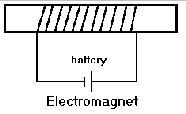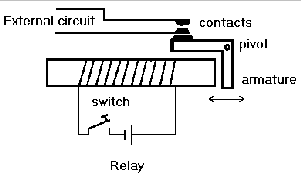 deflected
when placed near a wire carrying an electric current. If the wire is
coiled in a spiral, then the magnetic field will be perpendicular to
the direction of the current.
deflected
when placed near a wire carrying an electric current. If the wire is
coiled in a spiral, then the magnetic field will be perpendicular to
the direction of the current.
When an electric current passes through a conductor a
magnetic field is produced around the conductor. This effect can
be easily demonstrated by showing that a compass needle is  deflected
when placed near a wire carrying an electric current. If the wire is
coiled in a spiral, then the magnetic field will be perpendicular to
the direction of the current.
deflected
when placed near a wire carrying an electric current. If the wire is
coiled in a spiral, then the magnetic field will be perpendicular to
the direction of the current.
In an electromagnet a wire is wrapped around a soft iron core. When current is passed through the wire the core carries the magnetic flux and behaves like a bar magnet. This type of magnet has the advantage that the magnet field can be switched on or off.
 A relay
is an electromechanical
switching device. It has one or more contacts
for opening and closing circuits. A movable
metal strip called an armature is activated by an
electromagnet. The movement of the armature
causes the contacts to either open or close,
thereby turning a circuit on or off. In some
designs the armature is a drum that rotates
when the magnetic field is activated.
A relay
is an electromechanical
switching device. It has one or more contacts
for opening and closing circuits. A movable
metal strip called an armature is activated by an
electromagnet. The movement of the armature
causes the contacts to either open or close,
thereby turning a circuit on or off. In some
designs the armature is a drum that rotates
when the magnetic field is activated.
The reed relay is powered by the 9-volt battery. It closes at around .007 amperes, the current which passes through the circuit when the probes are connected to copper electrodes placed opposite each other in a 250 mL beaker half-filled with tap water. The electrodes may be held in place by crimping them around the beaker's lip. The reed relay may be activated as well by connecting the alligator directly together, without any damage to the reed relay.
The reed relay activates the intermediate relay which activates the power relay which turns on the light bulb.
The reed relay is capable of activating the power relay directly, but the initial current surge in the coil of the power relay might shorten the life of the reed relay. Hence, the intermediate "activator" relay.
Here are the specifications:
| Reed relay--> | "Activator" relay---> | Power relay---> | Light | |
| Coil | 0.004 Amps @
5 Volts D.C. |
0.01 Amps @
125 Volts A.C. |
0.08 Amps @
125 Volts A.C. |
0.6 Amps @
125 Volts A.C. |
| Output: (contact capacity) | 1 Amp @
125 Volts A.C. |
3 Amps @
125 Volts A.C. |
30 Amps @
125 Volts A.C. |

Directions: Plug unit into 110 V.A.C. Place on opposite sides of empty 250 mL beaker. Connect each probe wire to an electrode. Pour tap water slowly into the 250 mL beaker until reed relay closes and circuit activates, illuminating light.